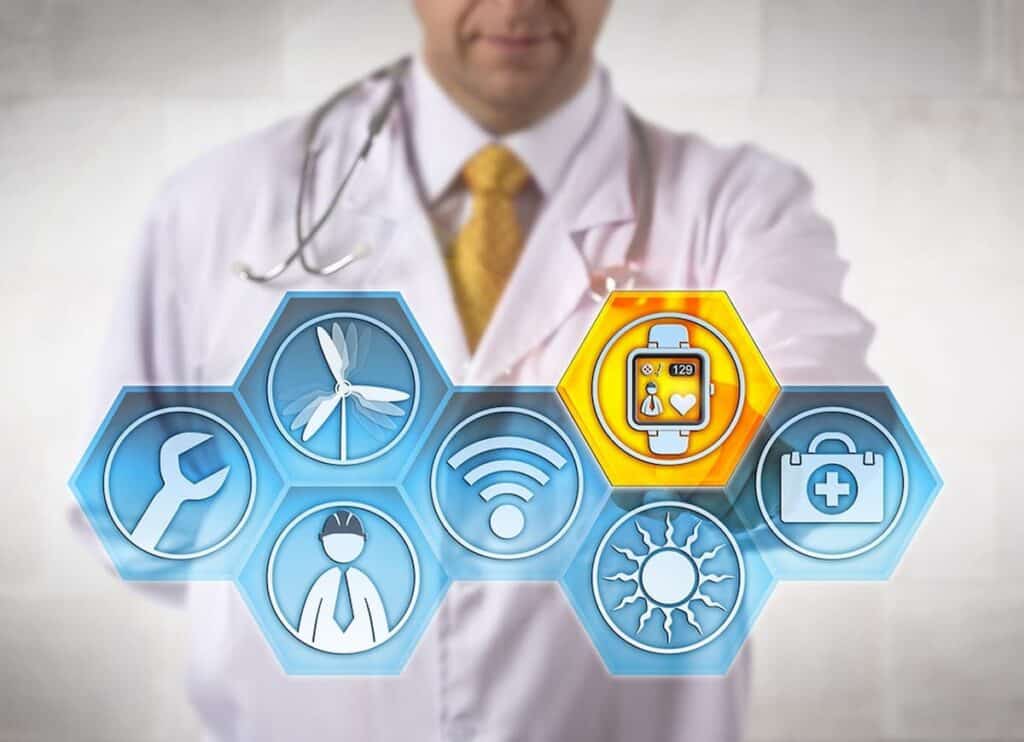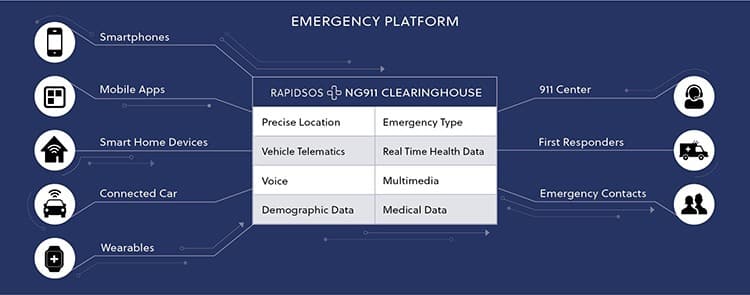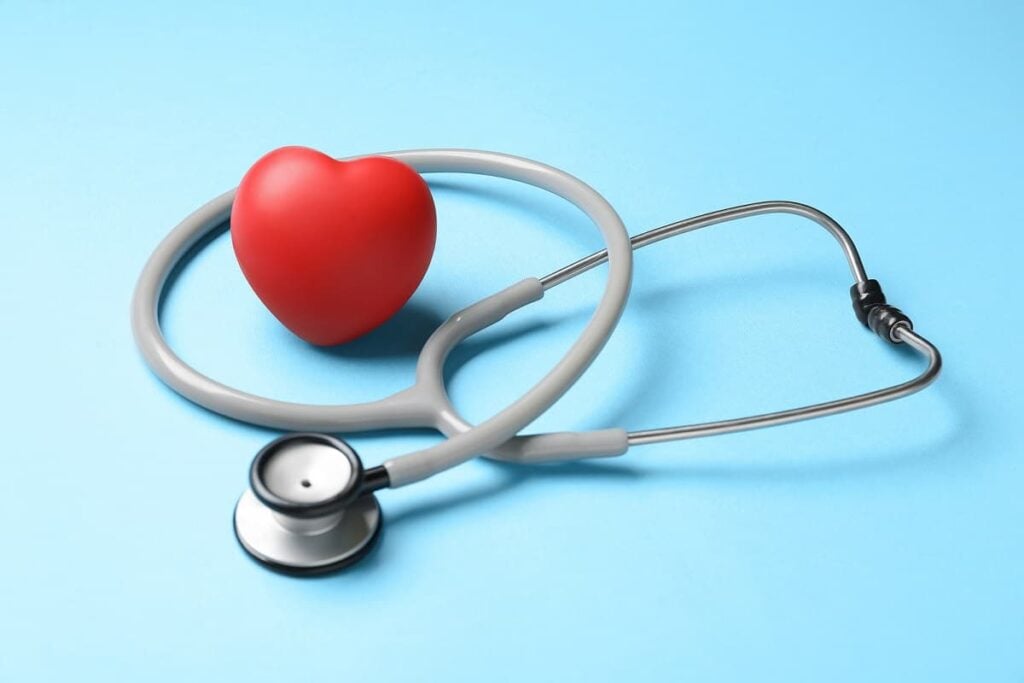5 IoT Healthcare Devices and Platforms for Digital Care
Table of contents

There are some trends out there that are hard to explain. Consider that the music video Gangnam Style has gotten more than 3.2 billion views on YouTube, probably making more money than the top-10 AI startups in South Korea combined. Some are much easier to explain, like everyone suddenly wanting to be a ganjapreneur and investing in pot stocks before the green rush is over. And some trends actually make financial sense. That’s what we’re starting to see when it comes to the so-called digitization of healthcare. After all, who wouldn’t want a piece of a $3.5 trillion market? In particular, the role of the Internet of Things – and, by default, Big Data and Artificial Intelligence – is poised to grow exponentially, as IoT healthcare devices find their way into everything from smart pills and smart inhalers to smart thermometers and nicotine patches.
Why IoT in Healthcare Could be Big Business
You don’t have to take our word for it. At this year’s IoT Evolution Expo in Fort Lauderdale, the program featured 10 sessions on IoT in healthcare. The opening discussion was hosted by a couple of representatives from SAS, a private data analytics company that’s been around since 1976. Healthcare analytics through AI and IoT is one of its key competencies, and the company is pushing hard for analytics as the best path toward what is called value-based healthcare. Value-based healthcare providers get paid to make you better rather than for throwing every blood test short of leeches at you. (A few PPOs still cover blood-letting, we’re told.) Such analytics require data from IoT healthcare devices to find that value:

A few fun facts from the presentation: Ye olde experts believe there will be some 20 billion IoT healthcare devices by 2020, up from a mere five million today. That equates to a $158 billion market by 2022, with healthcare startups raising some $1.5 billion in 2017, according to SAS. A variety of factors is driving the trend of IoT in healthcare, according to SAS, from advancements in sensors and machine learning to the anticipation of 5G connectivity to the popularity of wearables. Our recent coverage of Qolty shows how useful that data can be for medical research, something underscored by SAS and some local Florida universities that studied the benefits of IoT healthcare devices on the outcomes for pre-diabetic patients, for example.
And Why IoT in Healthcare can be Risky Business
During the course of our research, we came across a San Diego-based startup called Awarepoint thanks to an old market map (circa 2016) on IoT healthcare startups from the big brains at CB Insights, who used to offer more pro bono data before putting it all behind their high-priced paywall. Awarepoint developed Real-Time Location Systems (RTLS) for tracking medical equipment and people in medical settings. RTLS is kind of an indoor GPS – or a more sophisticated WiFi motion sensor – that uses sensors and a variety of technology platforms like WiFi and Bluetooth low energy to track people and assets. Awarepoint had taken in about $98 million since it was founded way back in 2002, according to Xconomy, before the startup suddenly shuttered some time last year. Of course, the collapse of a startup is nothing new, but we found more than one failed startup in this category, often being redirected to a site hawking derelict URLs, like a pawn shop for websites.

However, the Awarepoint story doesn’t quite end there. Another company, CenTrak, with a similar business in RLTS, bought some of Awarepoint’s assets last year. That’s cool, we thought, let’s cover CenTrak. Except the Philadelphia company was snatched up in 2016 for $140 million by UK-based Halma (LN:HLMA), which owns a bunch of health, safety, and medical technology companies, many of which build sensors and other IoT devices. But we’ll save them for another day and focus on IoT healthcare devices.
RTLS Tracking in Hospitals
Turns out there are a few companies offering IoT healthcare devices and platforms for indoor tracking, including a 22-year-old Norwegian company called Sonitor that has only raised one recorded, single round of venture capital – $9.5 million in 2016. Its Real Time Location System (RTLS) solution is based on ultrasound technology, using acoustic waves to track people and stuff in hospitals and medical clinics using different hardware and software packages. The main platform, Forkbeard (named after famed Norwegian navigator Sweyn Forkbeard, who dethroned his father, King Bluetooth – true story), is reputedly 100 times more accurate than Bluetooth low-energy systems, getting location accuracy down to inches. (Sounds like a whole new way to define the term “digital twin“.)

RLTS isn’t just useful for knowing where the bodies are, so to speak. Sonitor notes that its tags and receivers are now being used to track behaviors that can lead to infections. It can track the movement of people and equipment, such as wheelchairs and mattresses, to determine the time and exact location of when the zombie apocalypse began.
Medication Adherence
Medication adherence is a big problem in the United States, and we’re not just talking about the opioid crisis. Patients only take chronic medications properly about half the time, according to research, and nonadherence accounts for up to 50% of treatment failures, around 125,000 deaths, and up to 25% of hospitalizations each year in the United States. No wonder it’s become a focus in IoT healthcare. One of the leading startups in this space must be Proteus Digital Health, which has developed a sensor system for tracking medication. We first covered them way back in 2013. Today, the company has raised nearly a half-billion dollars, and in 2017 received the first FDA approval of a digital medicine system using its ingestible sensor, wearable patch, and app.
Such smart pills aren’t the only way to track medication adherence. There are also smart pill bottles from startups like New York-based AdhereTech. Founded in 2011, the company has raised $3.8 million in disclosed funding, including an undisclosed “significant strategic investment” from Argentum, a growth equity firm that focuses on “bootstrapped companies seeking $5 to $15 million of capital.” GE is a previous investor. Here’s basically how it works:

The company claims its customers include most of the major specialty pharmacies. No wonder: AdhereTech says its smart bottles can generate one to two additional fills of specialty (i.e., expensive) medications, per patient per year. It also claims its smart pill bottles improve duration on therapy by 26%, fill rates by 9%, and dose-level adherence by 15%.
Smart Bandages
One could say wearable sensors are responsible for really driving the IoT healthcare device trend in the first place. The space has certainly evolved beyond Fitbit and Apple Watch, with all sorts of smart wearables for athletes to improve their performance or sensors that help you keep the 20th promise to your spouse that you’ll quit smoking. Other types of wearables could save lives in a different way.
Founded in 2015, Flosonics Medical out of Canada raised $5 million last year for its smart bandage system called FloPatch, a wearable sensor that adheres to a patient’s neck and detects blood flow following clinical interventions. Targeted for ambulances, the emergency room, and intensive care units, FloPatch provides caregivers “physiological feedback on the effectiveness of their resuscitation, especially in the early stages of care.”
Update 02/03/2021: Flosonics Medical has raised $14 million in Series B funding for their commercial launch in North America and new product development. This brings the company’s total funding to $20 million to date.
Smart Beds
Smart beds sound like one of those First World solutions in search of a problem, but who are we to judge. Based in the city that never sleeps, New York startup Eight bills itself as the first sleep fitness company. It has raised about $30 million in disclosed funding since it was founded in 2014, including a $14 million Series B about a year ago led by Khosla Ventures. Crunchbase says the $15 billion mattress market is ripe for disruption from companies like Eight, which uses sensors embedded into its line of mattresses to collect data. Then algorithms go to work to provide insights on sleep patterns such as how to improve REM and Tinder scores.
Update 11/06/2019: Eight has raised $40 million in funding to invest heavily in research and development as well as workforce and retail growth. This brings the company’s total funding to $70.1 million to date.
Emergency Response
One of our favorite Nicolas Cage movies is Bring Out the Dead, in which he plays a paramedic going off the deep end. Just imagine a drug-addled Hunter S. Thompson showing up at your door to save your life, and you have the basic film plot. New York-based RapidSOS is helping keep these emergency responders sane by updating our antiquated 911 emergency system. The company, founded in 2013, has raised $65 million toward that goal, including $46 million over two rounds within the last year. It has partnered with both tech giants like Google and Apple, as well as major public safety software companies like Motorola and Raytheon.
RapidSOS is first and foremost about location, location, location. It turns out that the 6,500 call centers in the United States are still geared toward landline communications, despite the fact that up to 80% of emergency calls now come from cell phones, according to an article in Wired. While we might think that our GPS-enabled smartphone would make it easy to find us, the signal only gets you so close, though both Apple and Google have added emergency location services to device software to improve the results.

RapidSOS closes the gap further through its software. It provides not just better location, but additional information to call centers, such as make, model, and color of an Uber vehicle. The platform can also pull in other data, from wearables and other IoT healthcare devices that might be pertinent for first responders, such as vital signs from a smartwatch or whether the user was on a fatal Tinder date.
Update 06/09/2020: RapidSOS has raised $21 million in funding to continue expanding its data platform for first responders. This brings the company’s total funding to $119.7 million to date.
Conclusion
There are few emerging technologies with so many use cases as IoT, with the healthcare market coming to the forefront. As we collect more data about ourselves, the more we can improve our health and well-being. At least that’s the theory, and plenty of companies are buying into it. From GE buying a fetal sensor startup called Monica to Apple acquiring a sleep tracking startup named Beddit, the future of healthcare is in data and analytics. IoT healthcare devices and platforms will serve as the infrastructure of that transformation.
Sign up to our newsletter to get more of our great research delivered straight to your inbox!
Nanalyze Weekly includes useful insights written by our team of underpaid MBAs, research on new disruptive technology stocks flying under the radar, and summaries of our recent research. Always 100% free.















